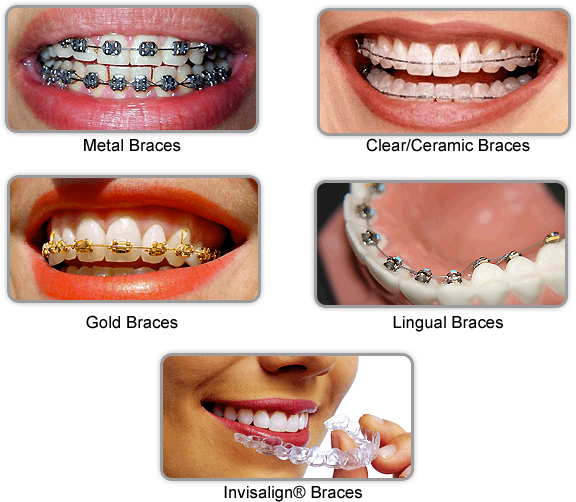In the past, the only option for people who wanted or needed straighter teeth was metal braces. While this option still exists, there are plenty of other treatments for those that simply cannot fit metal braces into their life. These alternatives all come along with their own lists of pros and cons. When deciding what kind of braces or straightening implements to get, it is important to know all of your options and to examine how each would fit into your life.
Pros of Metal Braces
Metal braces are still the most popular choice for straightening teeth, especially among young teenagers. Metal braces are the tried and true method for teeth straightening, and the techniques used with metal braces are widely known, well-practiced, and reliable. Out of all other kinds of braces, metal braces are the most popular because they are easy to apply, easy to maintain, safe, and work quickly. Alternative methods may ultimately have the same results, but they may not work as quickly or efficiently.
Cons of Metal Braces
If there were no negative aspects to metal braces, it is unlikely that people would ever have reservations to this type of treatment. However, metal braces can be painful and they are definitely a focal point of the face. Aside from just the brackets, most use plastic bands to help hold the wires in place and to adjust the bite, making them even more visible in a patient’s mouth.
They can also be, at times, painful. Any treatment used to move teeth is going to cause some aching in the jaw and teeth, but the brackets themselves take some getting used to and the wires, if ever dislodged, can poke the inside of the mouth and become very painful.
Ceramic Braces
Did you know that there are actually ceramic braces that function much in the same way that metal braces do? They still operate with a bracket and wire system, but because the ceramic brackets are the same shade of white as our teeth, they are far less noticeable. In some instances, they might even be clear, which is a definite improvement over metal braces.
They are more difficult to see and they work far better than other “clear” options. There might even be clear or white wires available, which will eliminate any need for shiny metal in your mouth.
Why choose ceramic braces over metal braces or Invisalign?
Invisalign, though it has been around for several years now, is still the big thing in orthodontics. Invisalign aligners are preferred among those that want to avoid the “metal mouth” appearance. However, there are some situations in which ceramic braces might be preferred over both Invisalign and traditional metal braces.
For example, if a patient wants the benefits of metal braces—that is, a speedy treatment that can address even severe problems—but does not want a mouth full of metal, ceramic braces are the perfect choice.
Lingual Braces
Lingual braces are not as popular as other kinds of braces, largely because they are more difficult to maintain and may even be more painful than regular braces. These braces are set on the insides of the bite, instead of on the outsides of teeth. When a person smiles or talks, the braces cannot be seen, unless they open their mouth very wide. They are more likely to collect food, and because they cannot be readily seen, they are more difficult to clean. For those who want to the benefits of metal braces but would prefer not to have the brackets on the outsides of the teeth, these kinds of braces might be the perfect fit.
Invisalign
Invisalign is a series of retainer-like trays. Each set of aligners is designed to move the teeth a little bit, pushing them into a more natural alignment. Invisalign is often marketed as an alternative to traditional braces, and for mild to moderate bite problems, they are an effective treatment.
Pros of Invisalign
The biggest positive of Invisalign aligners is their invisibility. While they are not completely invisible, they are far less noticeable than most other tooth straightening treatments. They are also reported to be less painful.
Not having metal brackets and wires in the mouth means that there is less poking of the gums and cheeks, and in general, the adjustment period to Invisalign trays is much shorter than with traditional braces. They can effectively straighten teeth, and they are easier than braces to clean and maintain. Because they can be removed from the mouth, it is easy to thoroughly brush the teeth and floss.
Cons of Invisalign
One of the biggest negatives of Invisalign is that the aligners cannot fix serious bite problems. They likely can only adjust the bite a small amount, lacking the leverage to really adjust the jaw. While they can straighten teeth, the process is going to be far more protracted over treatments like metal or ceramic braces.
Closing gaps, spreading out crowded teeth, and turning rotated teeth, if the problem is only mild, may be possible with Invisalign, but the aligners usually cannot deal with more serious problems.
The Bottom Line
Choosing what kind of treatment you proceed with is going to be a matter of discussion with your orthodontist. For some patients, Invisalign is the perfect choice. It enables them to continue living their life, without very many changes in their routine or lifestyle. Metal and ceramic braces do require a more significant adjustment period, but they are more effective than any other treatment.
Finding the right treatment for your teeth and life will be a matter of weighing how quickly you want your treatment to progress and what impact you want that treatment to have on your life.

